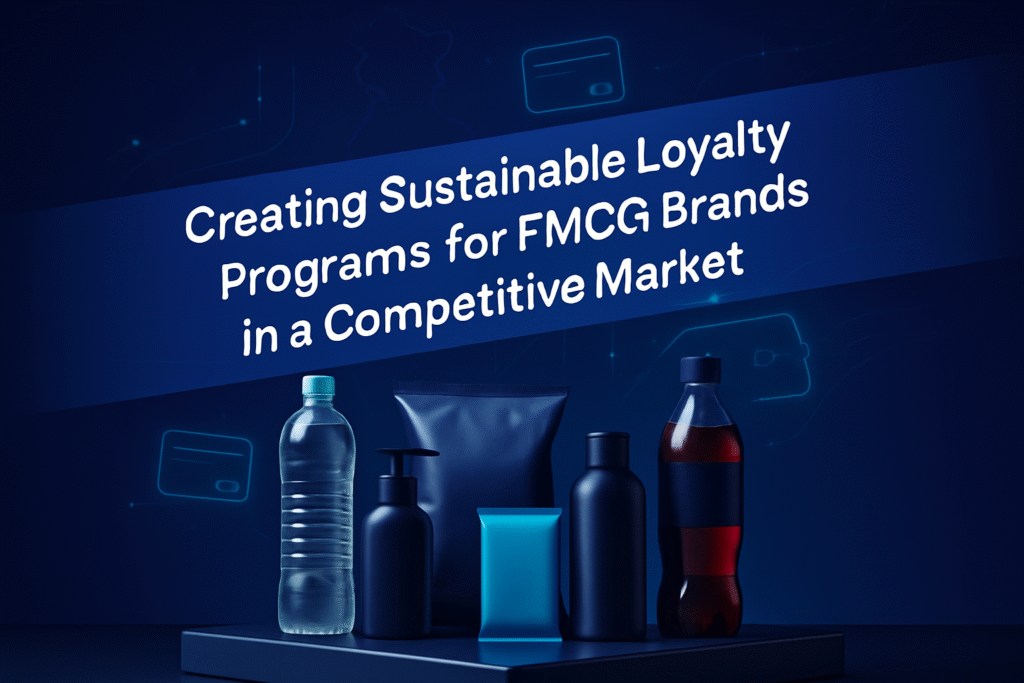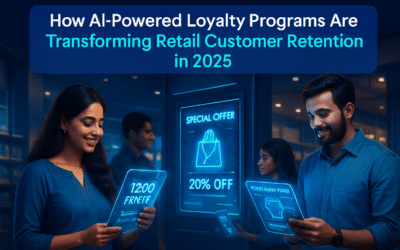FMCG Loyalty Strategies: Building Customer Retention in 2025
Introduction
The FMCG sector in India faces unprecedented challenges with customer acquisition costs rising by 60% in recent years. Brand loyalty in fast-moving consumer goods is increasingly difficult to maintain in today’s hyper-competitive market. Modern loyalty programs have evolved beyond simple points systems to become sophisticated engagement ecosystems. FMCG companies need strategic loyalty approaches that address unique industry challenges.
The Evolving Landscape of FMCG Loyalty Programs
The fast-moving consumer goods (FMCG) sector stands at a critical crossroads where creating sustainable loyalty programs for FMCG brands in a competitive market requires innovative approaches that align with consumer behavior. Today’s loyalty ecosystems must balance technological advancement with fundamental consumer needs in this high-volume, low-margin industry.
Digital Transformation Reshaping Customer Expectations
Traditional card-based loyalty systems are rapidly becoming obsolete as consumers embrace mobile-first experiences. Modern FMCG loyalty programs now integrate seamlessly with smartphones, offering immediate rewards and engagement opportunities. This shift is particularly evident in how brands are embedding loyalty touchpoints across multiple consumer interactions—from in-store purchases to social media engagement.
The integration with everyday consumer touchpoints reflects a deeper understanding that creating sustainable loyalty programs for FMCG brands in a competitive market means being present where customers naturally interact. Platforms like 1loyalty.ai facilitate this by supporting omnichannel reward structures that acknowledge customer activities across physical and digital spaces.
Customer expectations have also evolved toward hyper-personalization. Generic “buy 10, get 1 free” offers no longer suffice; today’s consumers anticipate rewards tailored to their specific preferences and purchase patterns. Effective loyalty programs now leverage data analytics to deliver precisely timed, relevant offers that genuinely resonate.
India’s Unique FMCG Loyalty Challenges
FMCG brands in India face distinctive challenges when creating sustainable loyalty programs for FMCG brands in a competitive market. The high-frequency, low-margin purchase patterns typical of this sector require carefully calibrated reward structures that maintain program viability while delivering meaningful value to customers.
The complex balance between online and offline loyalty journeys presents another substantial challenge. While urban centers demonstrate increasing digital adoption, significant portions of the market still prefer traditional shopping experiences. Successful loyalty programs must bridge this gap, offering seamless experiences regardless of purchase channel.
Price sensitivity remains a defining characteristic of Indian consumer behavior. Loyalty initiatives must acknowledge this reality by delivering genuine value without undermining product margins. Strategic approaches include tiered rewards that encourage increased purchase frequency or basket size while remaining conscious of consumer price thresholds.
Key Metrics That Matter for FMCG Loyalty Success
Measuring the effectiveness of loyalty initiatives requires tracking specific metrics. Repeat purchase rate serves as a primary indicator when creating sustainable loyalty programs for FMCG brands in a competitive market, revealing how successfully a program encourages ongoing engagement.
Customer lifetime value calculations provide critical insights into long-term program sustainability. These forecasts help brands balance immediate reward costs against projected future revenue streams, ensuring program viability while maximizing customer retention.
Share of wallet measurements offer perhaps the most valuable metric for FMCG brands, indicating how successfully loyalty programs capture consumer spending relative to competitors. Programs like those supported by 1loyalty.ai help brands establish meaningful benchmarks and track progress toward increased wallet share over time.
Data-Driven Personalization: The Core of Successful FMCG Loyalty
In today’s competitive landscape, creating sustainable loyalty programs for FMCG brands requires more than generic points systems. Data-driven personalization has emerged as the critical foundation for long-term customer retention and increased market share.
Leveraging Customer Data for Targeted FMCG Offers
The power of purchase history analysis cannot be overstated when developing effective loyalty initiatives. By examining what products customers buy repeatedly, FMCG brands can craft offers that align perfectly with established preferences. Customer segmentation takes this approach further by grouping consumers based on purchasing behavior, demographics, and engagement patterns.
For instance, a grocery chain using 1Loyalty.ai’s platform might identify distinct segments like health-conscious shoppers, bulk buyers, or premium product enthusiasts. This segmentation enables the creation of dynamic offers tailored to each group’s preferences, significantly increasing redemption rates while creating sustainable loyalty programs for FMCG brands that resonate with diverse customer bases.
Cross-Category Promotion Strategies
Successful FMCG loyalty programs extend beyond single-product rewards. Targeted cross-category rewards encourage customers to explore complementary items, expanding their basket size. A pharmacy might reward frequent skincare purchasers with points toward health supplements, creating value while introducing new product categories.
Complementary product recommendations based on data insights drive discovery while reinforcing loyalty. Strategic incentives that bridge category gaps represent a sophisticated approach to creating sustainable loyalty programs for FMCG brands in competitive markets. This approach transforms traditional loyalty from transactional to relationship-based engagement.
Behavioral Triggers and Real-Time Engagement
Understanding repurchase cycles allows FMCG brands to implement timely reminders just as products are likely running low. These perfectly timed communications prevent customers from switching to competitors during crucial replenishment moments.
Automated personalized communications based on individual purchasing patterns create meaningful touchpoints throughout the customer journey. When a regular purchaser deviates from their normal buying pattern, intelligent systems can trigger re-engagement offers to prevent churn. This proactive approach demonstrates how creating sustainable loyalty programs for FMCG brands requires anticipating customer needs before they even recognize them themselves.
By implementing these data-driven personalization strategies, FMCG brands can build loyalty programs that adapt to changing consumer preferences while delivering measurable business results.
Omnichannel Loyalty Approaches for FMCG Brands
In today’s fragmented consumer landscape, creating sustainable loyalty programs for FMCG brands in a competitive market requires seamless experiences across all touchpoints. Successful brands recognize that customers interact through multiple channels, making omnichannel loyalty strategies essential for building lasting relationships and driving repeat purchases.
Bridging Online and Offline Shopping Experiences
Modern FMCG consumers no longer distinguish between digital and physical shopping—they expect consistency everywhere. Effective loyalty programs must connect these experiences seamlessly. QR codes have emerged as powerful connectors, allowing brands to reward in-store purchases with digital benefits. For example, placing scannable codes on product packaging enables instant loyalty point collection without requiring separate loyalty cards.
The most successful implementations focus on data synchronization across channels. When a customer interacts with your brand online, their purchase history, preferences, and rewards should be instantly accessible when they visit physical retail locations. This cross-channel recognition is fundamental to creating sustainable loyalty programs for FMCG brands in a competitive market.
Partner Ecosystem Strategies
No FMCG brand exists in isolation. Building strategic partnerships creates value-multiplier effects in loyalty programs. Retailer collaborations enable brands to access valuable first-party data while offering more compelling rewards. These partnerships can transform traditional transactional loyalty programs into lifestyle ecosystems.
Complementary brand partnerships extend reach and enhance perceived value. For instance, a breakfast cereal brand might partner with a milk producer, allowing customers to earn consolidated rewards across both products. This approach not only enhances the customer value proposition but also distributes program costs across multiple parties, making creating sustainable loyalty programs for FMCG brands in a competitive market more economically viable.
Mobile-First Loyalty Design
With smartphone penetration varying widely across markets, successful FMCG loyalty programs must be accessible to all consumers. Mobile-first design ensures the widest possible adoption while delivering personalized experiences. Deep WhatsApp integration has proven particularly effective in markets with limited data connectivity or app fatigue.
The most innovative programs utilize mobile capabilities to drive both acquisition and retention. Location-based notifications, in-app product scanning, and mobile payment integration create frictionless loyalty experiences. 1Loyalty.ai’s platform helps FMCG brands design these experiences while gathering actionable customer insights for continuous program optimization—essential when creating sustainable loyalty programs for FMCG brands in a competitive market.
Measuring and Optimizing FMCG Loyalty Program Performance
In today’s market landscape, creating sustainable loyalty programs for FMCG brands in a competitive market requires continuous measurement and refinement. Successful brands understand that loyalty initiatives aren’t static – they demand ongoing analysis and optimization to maintain their effectiveness.
Essential Loyalty Analytics for Program Evaluation
Comprehensive analytics form the backbone of any successful loyalty initiative. When creating sustainable loyalty programs for FMCG brands, organizations must track engagement metrics like active participation rates, frequency of interactions, and customer lifetime value. The 1Loyalty.ai platform enables brands to monitor these metrics in real-time through intuitive dashboards that highlight both macro trends and individual customer behaviors.
Redemption pattern tracking provides equally valuable insights, revealing which rewards resonate most with customers. This data helps FMCG brands optimize their reward offerings by identifying the perfect balance between aspirational high-value rewards and easily attainable quick wins. By analyzing these patterns, brands can develop loyalty structures that motivate ongoing participation while controlling program costs.
Iterative Program Improvement Through Testing and Adaptation
Creating sustainable loyalty programs for FMCG brands requires embracing a test-and-learn mindset. A/B testing different program elements – from reward structures to communication frequency – helps identify the most effective approaches. For instance, testing various point expiration timeframes might reveal the optimal balance between encouraging redemption and preventing point hoarding.
Seasonal adaptation is equally crucial. FMCG brands must adjust their loyalty strategies to align with seasonal consumer behaviors and preferences. This might involve special summer promotions or holiday-themed reward catalogs that keep the program feeling fresh and relevant year-round.
ROI Calculation Frameworks for Program Evaluation
Measuring loyalty program ROI begins with establishing accurate baseline metrics. Before launching initiatives focused on creating sustainable loyalty programs for FMCG brands, companies should document key performance indicators like purchase frequency, average transaction value, and customer retention rates.
A comprehensive assessment framework should track both direct financial impacts (increased purchase frequency, higher basket size) and indirect benefits (improved customer satisfaction, enhanced brand perception). The most sophisticated FMCG loyalty programs use attribution modeling to understand how loyalty initiatives influence overall customer behavior across multiple touchpoints and channels.
Conclusion
FMCG loyalty programs require specialized approaches that address the unique challenges of high-frequency, low-margin purchases. Data-driven personalization and omnichannel experiences are fundamental to modern FMCG loyalty strategies. With the right technology partner like 1loyalty.ai, FMCG brands can build sophisticated loyalty ecosystems that drive measurable business results. The most successful FMCG loyalty strategies balance transactional benefits with emotional connections to create lasting customer relationships.
Ready to transform your FMCG loyalty approach? Connect with 1loyalty.ai’s team of experts to design a customized loyalty strategy for your specific business needs.


